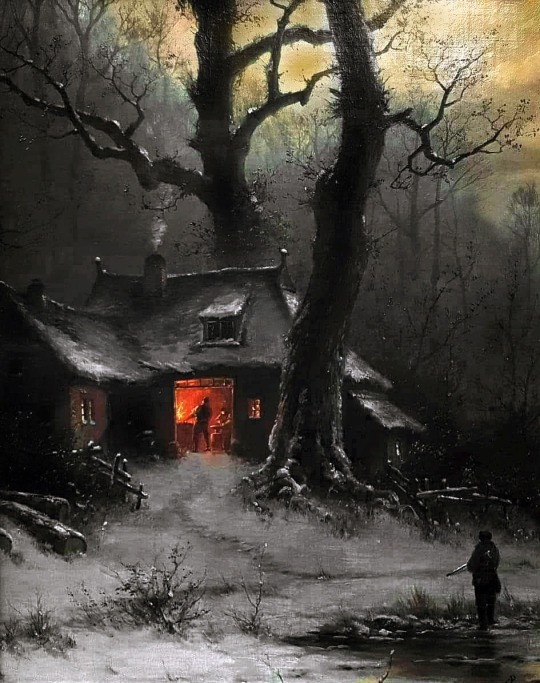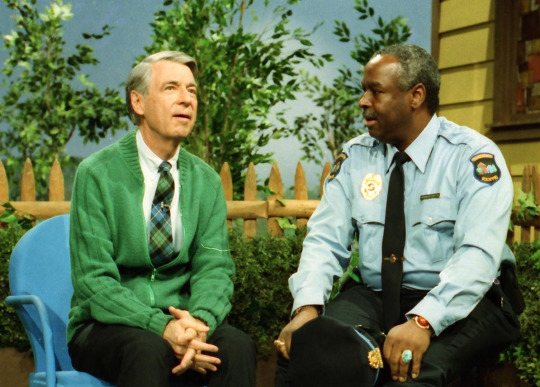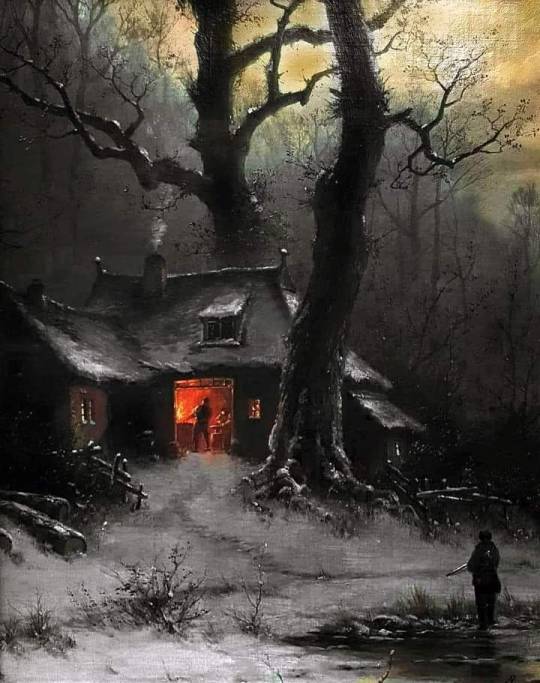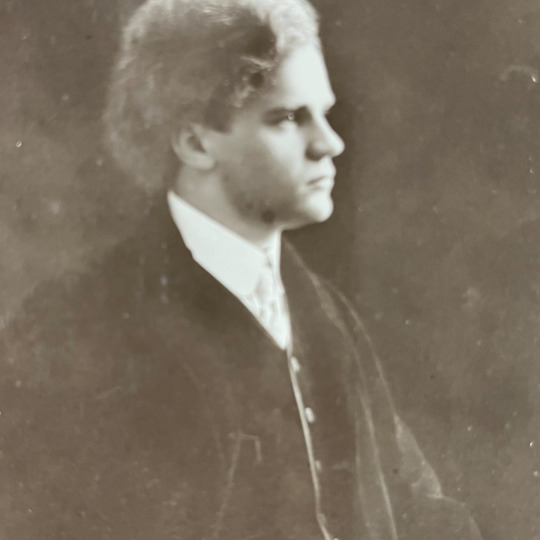#1791-1868
Text

Snowy landscape with a hunter and a forge
by August Friedrich Piepenhagen (1791-1868)
0 notes
Photo

August Piepenhagen (German, 1791-1868)
Hegyszakadék holdvilágban, 19th century
Déri Museum
#august piepenhagen#piepenhagen#german#landscape#landscape painting#art#fine art#classical art#Hegyszakadék holdvilágban#germany#traditional art#oil painting#european art#europe#europa#night#night painting
2K notes
·
View notes
Text
THIS DAY IN GAY HISTORY
based on: The White Crane Institute's 'Gay Wisdom', Gay Birthdays, Gay For Today, Famous GLBT, glbt-Gay Encylopedia, Today in Gay History, Wikipedia, and more … April 23



1616 – On this date the English writer and actor William Shakespeare died. He was born in 1564 and baptised on the 26 April, probably within 2 or 3 days of his birthdate. (One legend is that he died on the day that he was born - which would make his birthdate also today, 23 April)
Shakespeare is the most important playwright and poet in the English or any other language, but Shakespeare's sonnets are cited as evidence of his possible homosexuality.
The poems were initially published, perhaps without his approval, in 1609. One hundred and twenty-six of them appear to be love poems addressed to a beautiful young man whom he addresses as 'Fair Lord' or 'Fair Youth'; this is often assumed to be the same person as the 'Mr W.H.' to whom the sonnets are dedicated. The identity of this figure (if he is indeed based on a real person) is unclear; the most popular candidates are Shakespeare's patrons, Henry Wriothesley, 3rd Earl of Southampton and William Herbert, 3rd Earl of Pembroke, both of whom were considered handsome in their youth.
It remains unclear whether the Fair Lord and Fair Youth addressed represent real individuals, or even whether the authorial "I" who addresses them represents Shakespeare himself, though Wordsworth believed that with the sonnets "Shakespeare unlocked his heart".
Even though he married Anne Hathaway and had three children, the circumstantial evidence, such as in his sonnets and plays, suggests he did have an erotic interest in men. Evidence of these homosexual tendencies comes from an analysis of his sonnets, which address his "great love," who seems be a young man.


1791 – Today's the birthday of James Buchanan (d.1868), the 15th President of the United States and the nation's only bachelor chief executive, unanimously considered worst president in U.S. history.
For fifteen years in Washington, D.C., prior to his presidency, Buchanan lived with his "close friend," Alabama Senator William Rufus King. King became Vice President under Franklin Pierce. He took ill and died shortly after Pierce's inauguration, and four years before Buchanan became President. Buchanan and King's close relationship prompted the surly Andrew Jackson to refer to King as "Miss Nancy" and "Aunt Fancy," while Aaron V. Brown spoke of the two as "Buchanan and his wife." Further, some of the contemporary press also speculated about Buchanan and King's relationship.

William Rufus King
Buchanan's and King's nieces destroyed their uncles' correspondence, leaving some questions as to what relationship the two men had, but the length and intimacy of surviving letters illustrate "the affection of a special friendship", and Buchanan wrote of his "communion" with his housemate . The circumstances surrounding Buchanan and King's close emotional ties have led most open historians to speculate that he was America's first homosexual president.
Perry Brass wrote us to tell us that in "several cities, most notably Washington, DC, 'James Buchanan Clubs' popped up, joined by wealthy bachelors. The clubs purported to be a place where bachelor men could 'network,' before that word became a verb, but the actual basis of the club was pretty well known: they were clubs for (somewhat) closeted A-gays. Another version of the clubs were called 'Steamboat clubs,' and I'm not sure where that word came from, although I think it had some connection with the Buchanan era as well."
Why was he such a bad president? Well, in a nutshell, most historians consider him responsible for letting the country fall apart into the Civil War. He acquiesced to Southern states (even though he himself was a Pennsylvanian). Buchanan's efforts to maintain peace between the North and the South alienated both sides. As the Southern states declared their secession in the prologue to the American Civil War, Buchanan's opinion was that secession was illegal, but that going to war to stop it was also illegal; hence he remained inactive.
By the time he left office, popular opinion had turned against him and the Democratic Party had split in two. His handling of the crisis preceding the Civil War has led to his consistent ranking by historians as one of the worst Presidents in American history.
If you visit Washington, DC, you can see the lovingly restored cottage of Buchanan's successor (and perhaps the second homosexual President) Abraham Lincoln. Located at the Old Soldiers Home near Rock Creek Park, the cottage underwent a complete renovation to return it to period authenticity as the summer home of the Lincolns during the civil war. What does this have to do with Buchanan? Well, if you stand in the front yard of the Lincoln cottage, across the way you'll see the beautiful cottage that was the summer home to Buchanan and King on those hot steamy Washington summers of long ago.


1882 – The Chilean novelist Augusto Goemine Thomson better known as Augusto D'Halmar was born on this date. He is best known as the author of the novel "Pasión y muerte del Cura Deusto" which was published in 1924. It was one of the first novels to deal with homosexuality in an open way. In 1942 D'Halmar was awarded the Premio Nacional de Literatura. He was the first recipient of the honor.


1918 – James Kirkup (d.2009) was a prolific English poet, translator and travel writer. He wrote over 30 books, including autobiographies, novels and plays. He became a Fellow of the Royal Society of Literature in 1962.During World War II he was a conscientious objector, and worked for the Forestry Commission and on the land in the Yorkshire Dales.He taught at The Downs School in Colwall, Malvern, where W.H. Auden had earlier been a master. Kirkup wrote his first book of poetry, The Drowned Sailor at the Downs, which was published in 1947.
In 1952 he moved south to Gloucestershire and became visiting poet at Bath Academy of Art for the next three years. Moving on from Bath, he taught in a London grammar school before leaving England in 1956 to live and work in Europe, the Americas and the Far East. In Japan, he found acceptance and appreciation of his work, and he settled there for 30 years, lecturing in English literature at several universities.
Kirkup came to public attention in 1977, after the newspaper Gay News published his poem The Love That Dares to Speak Its Name, in which a Roman centurion describes his lust for and attraction to the crucified Jesus. The paper was successfully prosecuted in the Whitehouse v. Lemon case, along with the editor, Dennis Lemon, for blasphemous libel under the 1697 Blasphemy Act, by Mary Whitehouse, then Secretary of the National Viewers' and Listeners' Association.
You can read the poem here: The Love That Dares To Speak Its Name


Mister Rogers with Officer Clemmons
1945 – François Clemmons is an American singer, actor, playwright and university lecturer. He is perhaps best known for his appearances as "Officer Clemmons" on the PBS television series Mister Rogers' Neighborhood from 1968 to 1993.
Clemmons was born in Birmingham, Alabama and raised in Youngstown, Ohio. When it was discovered that he had an excellent singing voice, he began performing locally at church functions. He became choir director of his church at the age of 10. His first songs were the spirituals of pre-Civil War America, passed down to him by his mother. He soon branched out across genres, singing with various community groups. For a while, he was the lead singer of a rock 'n' roll group called the Jokers.
Clemmons received a Bachelor of Music degree from Oberlin College, and a Master of Fine Arts from Carnegie Mellon University. He also received an honorary degree of Doctor of Arts from Middlebury College.For 25 years, Clemmons performed the role of Officer Clemmons, a friendly neighborhood policeman, in the "Neighborhood of Make-Believe" on the children's television show Mister Rogers' Neighborhood. In the neighborhood itself, Clemmons ran a singing and dance studio located in the building diagonally across the street from Mister Rogers' house. He was one of the first African Americans to have a recurring role on a kids' TV series, and his presentation – as both a beloved neighbor to Mister Rogers and as a respected authority figure – has been described as a ground-breaking message in race relations.
While attending Oberlin College, Clemmons realized that he was gay, but remained closeted, fearing disapproval from his religious family and the community. In 1968, Fred Rogers told Clemmons that while his sexuality did not matter to him personally, Clemmons could not be "out" and continue appearing on Mister Rogers' Neighborhood, because of the scandal that would arise. In the late 1960s, Rogers and others suggested that Clemmons get married as a way to deal with his sexual orientation, which he did. His marriage to wife Carol did not work out, and Clemmons divorced in 1974 so that he could live openly as a gay man. Rogers remained personally supportive of Clemmons, but required him to avoid any indication of his homosexuality – such as the earring he began to wear as a signifier – on the program.
Clemmons lives and works in Middlebury, Vermont, where he is the Emeritus Artist in Residence of Middlebury College. He is a member of Phi Mu Alpha Sinfonia, the national fraternity for men in music.


1957 – Alex Sanchez's unique background as a youth and family counselor and his experiences as an immigrant have helped make him an important voice in today's young adult glbtq literature canon. Born in Mexico City, Mexico, to parents of both Cuban and German descent, Sanchez immigrated with his family to Texas in 1962 at the age of five.
In a panel discussion at the 2003 National Council of Teachers of English convention, he explained, "Because of my light-skinned father and his German last name (not Sanchez), I learned I could pass as white. I could hide who I was, so that others would like and accept me."
At age 13, Sanchez realized that he was gay. He once again experienced feelings of being an outsider. But this time he felt there was no one he could talk to or relate to. He found no books in the library that described what he was going through, and none to tell him that what he felt was okay.
"So," he explained, "just as I had learned to hide that I was Mexican, I tried to hide that I was gay. I became depressed, quiet, invisible, trying to escape calling attention to myself."
After graduation, he worked as a family and youth counselor for ten years. During that time, he began to write the story that would eventually become Rainbow Boys (2001).
The book features three distinct and well-developed gay teens: an "out-and-proud" gay activist, a jock who starts the book with a girlfriend and family issues, and a low-key closeted teen who experiences prejudice due to his friendship with the more flamboyant character. The characters' stories are continued in Rainbow High (2003) and Rainbow Road (2005).
Considering that the average age most gay Americans now "come out" has dropped from age 21 (in 1979) to around 15 today (and as low as ten), the need for middle-grade glbtq fiction is obvious.
Alex Sanchez is one of today's most influential authors for the glbtq young adult market. His popularity and success is due to many factors, but most notably his believable characters, the timely and relevant storylines of his novels, and the broad appeal of the stories to both gay and straight teens.
Sanchez's books have helped countless gay teens accept themselves while at the same time helping straight readers understand and empathize with gay teens.


1984 – Aras Onur is a Turkish author, poet, and columnist.
Aras Onur was born in Ankara and is a graduate of TED Ankara College and University of Ankara. He started his literary career in the early 2000s. Openly gay, he has been often associated with local LGBT literature.
He is often identified as a socialist in the media, although his conservative tendencies are also often noted. Aras Onur was mastermind of "Kindle a Candle" protests, a wave of civil unrests in Turkey which began on 11 September 2015. The protesters were spurred on by a manifesto released by columnists of the national newspaper Karsi, in which the slogan "Kindle a Candle, Stand Out" was featured.
Onur had written Karsi editorial columns for two years as the acting-editor until he resigned from office in October 2016, following a ban on accessing the paper's website.


1984 – The US Dept. of Health and Human Services Secretary holds a press conference announcing that the virus that causes AIDS has been discovered: it’s HTLV-3, known today as HIV ('human immunodeficiency virus'). AIDS was originally named called GRID – 'gay related immune deficiency'.


2013 – The French Senate approves same-sex marriage.


19 notes
·
View notes
Text

OTD in Music History: Legendary Italian opera composer Gioachino Rossini (1792 – 1868) would be celebrating his 58th birthday today if he were still alive to blow out the candles on a cake.
Wait, what?
Well, every great musical figure has a birthdate – but very few were born on February *29th*.
Rossini held the rare distinction of being a “leap year” baby, which means that although he lived on Earth for 76 full rotations around the Sun (an impressive run back in the 19th Century), he nevertheless died of age-related illnesses before he ever had a chance to celebrate his 20th birthday.
This quirk of the modern calendar also means that technically speaking, Rossini managed to compose all of his operas and settle into a long and comfortable retirement before his 10th birthday even rolled around… and you thought W.A. Mozart (1756 – 1791) was the greatest prodigy in musical history!
PICTURED: A c. 1960s real photo postcard showing the elderly Rossini as he would have appeared shortly after celebrating his 18th birthday (in his late 60s).
#classical music#opera#music history#bel canto#composer#classical composer#aria#classical studies#maestro#chest voice#opera history#Gioachino Rossini#classical musician#classical musicians#classical history#history of music#historian of music#musician#musicians#diva#prima donna#Opéra Paris#The Barber of Seville#Il barbiere di Siviglia#Semiramide#Otello#opera buffa#William Tell
14 notes
·
View notes
Text

Antonio Salieri (18 August 1750 – 7 May 1825) was an Italian composer and teacher of the Classical period. He was born in Legnago, south of Verona, in the Republic of Venice, and spent his adult life and career as a subject of the Habsburg monarchy.
Salieri was a pivotal figure in the development of late 18th-century opera. As a student of Florian Leopold Gassmann, and a protégé of Christoph Willibald Gluck, Salieri was a cosmopolitan composer who wrote operas in three languages. Salieri helped to develop and shape many of the features of operatic compositional vocabulary, and his music was a powerful influence on contemporary composers.
Appointed the director of the Italian opera by the Habsburg court, a post he held from 1774 until 1792, Salieri dominated Italian-language opera in Vienna. During his career, he also spent time writing works for opera houses in Paris, Rome, and Venice, and his dramatic works were widely performed throughout Europe during his lifetime. As the Austrian imperial Kapellmeister from 1788 to 1824, he was responsible for music at the court chapel and attached school. Even as his works dropped from performance, and he wrote no new operas after 1804, he still remained one of the most important and sought-after teachers of his generation, and his influence was felt in every aspect of Vienna's musical life. Franz Liszt, Franz Schubert, Ludwig van Beethoven, Anton Eberl, Johann Nepomuk Hummel and Franz Xaver Wolfgang Mozart were among the most famous of his pupils.
Salieri's music slowly disappeared from the repertoire between 1800 and 1868 and was rarely heard after that period until the revival of his fame in the late 20th century. This revival was due to the fictionalized depiction of Salieri in Peter Shaffer's play Amadeus (1979) and its 1984 film version. The death of Wolfgang Amadeus Mozart in 1791 at the age of 35 was followed by rumors that he and Salieri had been bitter rivals, and that Salieri had poisoned the younger composer; however, this has been proven untrue because the symptoms displayed by Mozart's illness did not indicate poisoning and it is likely that they were, at least, mutually respectful peers. Despite denying the allegation, Salieri was greatly affected by the accusations and widespread public belief that he had contributed to Mozart's death, which led to his nervous breakdowns later in life. In November 1823 Salieri attempted suicide. He was committed to medical care and suffered dementia for the last year and a half of his life.
5 notes
·
View notes
Text

August Friedrich Piepenhagen (1791-1868)
10 notes
·
View notes
Text
The Best Classical Music
The Best Symphony
Ludwig van Beethoven (1770-1827) - Symphony No. 6 in F Major, Op. 68 (“Pastoral”) (1808) Best Sixth Symphony
Ludwig van Beethoven (1770-1827) - Symphony No. 9 in D minor, Op. 125 (“Choral”) (1824)
Antonin Leopold Dvorak (1841-1904) - Symphony No. 9 in E minor, Op. 95, B. 178 (“From the New World”) (1893) Best Ninth Symphony
Charles-Camille Saint-Saens (1835-1921) - Symphony No. 3 in C minor, Op. 78 (“Organ”) (1886)
Ludwig van Beethoven (1770-1827) - Symphony No. 7 in A Major, Op. 92 (1812)
Sergei Vasilievich Rachmaninov (1873-1943) - Symphony No. 2 in E minor, Op. 27 (1907) Best Second Symphony
Ludwig van Beethoven (1770-1827) - Symphony No. 5 in C minor, Op. 67 (“Fate”) (1808)
Gustav Mahler (1860-1911) - Symphony No. 5 in C sharp minor (1902)
Pyotr Ilyich Tchaikovsky (1840-1893) - Symphony No. 6 in B minor, Op. 74 (“Pathetique”) (1893)
Henryk Mikolaj Gorecki (1933-2010) - Symphony No. 3, Op. 36 (“Symphony of Sorrowful Songs”) (1976)
Pyotr Ilyich Tchaikovsky (1840-1893) - Symphony No. 5 in E minor, Op. 64 (1888) Best Fifth Symphony
Ludwig van Beethoven (1770-1827) - Symphony No. 3 in E flat Major, Op. 55 (“Eroica”) (1804)
Gustav Mahler (1860-1911) - Symphony No. 2 in C minor (“Resurrection”) (1894)
Jean Johan Julius Christian Sibelius (1865-1957) - Symphony No. 5 in E flat Major, Op. 82 (1919)
Jean Johan Julius Christian Sibelius (1865-1957) - Symphony No. 2 in D Major, Op. 43 (1902)
Hector Berlioz (1803-1869) - Symphonie Fantastique, Op. 14 (1830)
Franz Peter Schubert (1797-1828) - Symphony No. 9 in C Major, D. 944 (“Great”) (1826)
Gustav Mahler (1860-1911) - Symphony No. 1 in D Major (“Titan”) (1894)
Dmitry Dmitriyevich Shostakovich (1906-1975) - Symphony No. 5 in D minor, Op. 47 (1937)
Antonin Leopold Dvorak (1841-1904) - Symphony No. 8 in G Major, Op. 88, B. 163 (1890)
Ludwig van Beethoven (1770-1827) - Symphony No. 4 in B flat Major, Op. 60 (1806) Best Fourth Symphony
Wolfgang Amadeus Mozart (1756-1791) - Symphony No. 41 in C Major, K. 551 (“Jupiter”) (1788)
Johannes Brahms (1833-1897) - Symphony No. 1 in C minor, Op. 68 (1876)
Wolfgang Amadeus Mozart (1756-1791) - Symphony No. 40 in G minor, KV. 550 (“The Great G minor”) (1788)
Jakob Ludwig Felix Mendelssohn Bartholdy (1809-1847) - Symphony No. 4 in A Major, Op. 90 (“Italian”) (1833)
Johannes Brahms (1833-1897) - Symphony No. 4 in E minor, Op. 98 (1885)
Jakob Ludwig Felix Mendelssohn Bartholdy (1809-1847) - Symphony No. 3 in A minor, Op. 56 (“Scottish”) (1842)
Sergei Prokofiev (1891-1953) - Symphony No. 1 in D Major, Op. 25 (“Classical”) (1917)
Pyotr Ilyich Tchaikovsky (1840-1893) - Symphony No. 4 in F minor, Op. 36 (1878)
Jean Johan Julius Christian Sibelius (1865-1957) - Symphony No. 1 in E minor, Op. 39 (1899) Best First Symphony
Johannes Brahms (1833-1897) - Symphony No. 3 in F Major, Op. 90 (1883) Best Third Symphony
Gustav Mahler (1860-1911) - Symphony No. 8 in E flat Major (“Symphony of a Thousand”) (1907) Best Eighth Symphony
Josef Anton Bruckner (1824-1896) - Symphony No. 7 in E Major, WAB 107 (1885) Best Seventh Symphony
Ralph Vaughan Williams (1872-1958) - Symphony No. 5 in D Major (1943)
Franz Joseph Haydn (1732-1809)- Symphony No. 94 in G Major, Hob. 1/94 (“Surprise”) (1791)
The Best Piano Concerto
Wolfgang Amadeus Mozart (1756-1791) - Piano Concerto No. 20 in D minor, K. 466 (1785)
Johannes Brahms (1833-1897) - Piano Concerto No. 2 in B flat Major, Op. 83 (1881)
Sergei Vasilievich Rachmaninov (1873-1943) - Piano Concerto No. 2 in C minor, Op. 18 (1901)
Edvard Hagerup Grieg (1843-1907) - Piano Concerto in A minor, Op. 16 (1868)
Robert Schumann (1810-1856) - Piano Concerto in A minor, Op. 54 (1845)
Ludwig van Beethoven (1770-1827) - Piano Concerto No. 5 in E flat Major “Emperor’, Op. 73 (1811)
Sergei Prokofiev (1891-1953) - Piano Concerto No. 3 in C Major, Op. 26 (1921)
Joseph-Maurice Ravel (1875-1937) - Piano Concerto in G Major (1931)
Ludwig van Beethoven (1770-1827) - Piano Concerto No. 4 in G Major, Op. 58 (1806)
Wolfgang Amadeus Mozart (1756-1791) - Piano Concerto No. 23 in A Major, K. 488 (1786)
Johann Sebastian Bach (1685-1750) - Harpsichord Concerto No. 3 in D Major, BWV 1054 (1721)
Wolfgang Amadeus Mozart (1756-1791) - Piano Concerto No. 21 in C Major, K. 467 (1785)
Sergei Vasilievich Rachmaninov (1873-1943) - Piano Concerto No. 3 in D minor, Op. 30 (1909)
Pyotr Ilyich Tchaikovsky (1840-1893) - Piano Concerto No. 1 in B flat minor, Op. 23 (1875)
Joseph-Maurice Ravel (1975-1937) - Piano Concerto for the Left Hand in D Major (1930)
Johannes Brahms (1833-1897) - Piano Concerto No. 1 in D minor, Op. 15 (1858)
Frederic Francois Chopin (1810-1849) - Piano Concerto No. 2 in F minor, Op. 21 (1830)
Johann Sebastian Bach (1685-1750) - Harpsichord Concerto No. 1 in D minor, BWV 1052 (1721)
Camille Saint-Saens (1835-1921) - Piano Concerto No. 2 in G minor, Op.22 (1868)
Bela Viktor Janos Bartok (1881-1945) - Piano Concerto No. 3 in E Major, Sz. 119, BB 127 (1945)
Jakob Ludwig Felix Mendelssohn Bartholdy (1809-1847) - Piano Concerto No. 1 in G minor, Op. 25 (1831)
Frederic Francois Chopin (1810-1849) - Piano Concerto No. 1 in E minor, Op. 11 (1830)
Franz Liszt (1811-1886) - Piano Concerto No. 1 in E flat Major, S.124 (1849)
2 notes
·
View notes
Note
I knew about Richard Mille but not about the rest, so thank you. This is interesting 👀 //
you're welcome 😊 I had some time today, so I did some additional research on the other brands present in F1 this year:
• Red Bull: Tag Huer (1860, with Red Bull since 2013) > racing is a big part of their history: rallying in the 50s, Carrera inspired/tribute to the Carrera Panamericana in 1963, iconic Monaco in 1969 + link with McQueen, major partnership with Ferrari in the 70s, then became the main supplier of watches for F1 in the 80s (they made a few watches from it) + partnership with Ayrton Senna
• Ferrari/McLaren: Richard Mille (founded in 2011, with McLaren since 2016 after Tag Huer left for Red Bull - with Ferrari since 2021 after Hublot left - Hublot still sponsor Zhou Guanyu this year, and since 2018) > their history is really linked to racing, the two passions of the founder: F1, endurance, Le Mans Classic, Chantilly
• Alfa Romeo: Rebellion Timepieces (founded in 2009, with Alfa since this year after Richard Mille left) > is also an endurance racing team
• Williams: Bremont Watches: (founded in 2002, with Williams since last year) > they have a partnership with Jaguar since 2010 and have developed odometers and created special watches with/about them, they are the main partner of the Isle of Man Tourist Trophy (motorbike road race, known to be very dangerous), and something with classic/collector cars
• Haas: Cyrus Geneva: (founded in 2010, with Haas since last year after Richard Mille left) > they also sponsor a FE driver, Maximilian Günter
• Aston Martin: Girard-Perregaux: (founded in 1791, with Aston since last season) > I think this is their first step into the world of racing
• Mercedes: IWC (founded in 1868, with Merc since 2013) > not into racing, but in aviation among other things; they also sponsor Tom Brady & Tottenham Hotspur
• Alpine: Bell & Ross (founded in 1992, with Renault/Alpine since 2016) > were suppliers to the army and the UN, their image was linked to aviation and the army before their deal with Renault
• Alpha Tauri: they don't have a watch supplier that I know of, but I think they had a deal with Casio at some point🤔
• and last, Rolex has been the official timekeeper and official watch of F1 since 2013, their history in F1 and the sport in general is huge and really interesting 😊
NONNIE THIS IS AMAZINGGG! Thank you so much ❤️
7 notes
·
View notes
Text
"Thomas has also advocated abandoning fundamental First Amendment protections for the press and any constitutional rights at all for children, because these rights were not recognized in 1791 or 1868. And he maintains that the establishment clause should apply only to the federal government, leaving states free to fund or even endorse specific religious denominations. The fact that he stands alone on almost all these positions only underscores the illegitimacy of originalism. If a theory cannot be applied consistently without consequences that are untenable even to most of its proponents, it's an untenable theory. And if those consequences lead its practitioners to abandon the theory on a regular basis, it hardly constrains judicial discretion in a meaningful way."
David Cole, "Originalism's Charade," 2022
1 note
·
View note
Text
MEXICO CITY, MEXICO STREET ART: LEGENDARY MUSICAL ICONS by KOKA
Ludwig van Beethoven (baptised 17 December 1770 – 26 March 1827) was a German composer and pianist.
Wolfgang Amadeus Mozart (27 January 1756 – 5 December 1791) was a prolific and influential composer of the Classical period.
José Juventino Policarpo Rosas Cadenas (25 January 1868 – 9 July 1894) was a Mexican composer and violinist.
Adelina Patti (19 February 1843 – 27 September 1919) was an…

View On WordPress
#art#cdmx#Graffiti#life#mexico#mexico city#murals#nomad#photography#Street Art#TOKIDOKI Nomad blog#TOKIDOKI Nomad travel blog#Travel#urban art#World Travel
0 notes
Text










I reached back in to Bengaluru’s history today with a visit to Bengaluru Fort and Tipu Sultan’s Summer Palace.
The original Bengaluru Fort was built by the city’s founder Kempegowda I in 1537 as a mud fort. This was replaced and renovated by Hyder Ali in 1761. There are now only a few remnants.
Tipu Sultan’s Summer Palace was built by Tipu Sultan’s father Hyder Ali and completed in 1791 and predominately made from teakwood. It is located in what was the wider footprint of Bengaluru Fort. It is an example of Indo-Islamic architecture and the two-storey Palace would have been quite opulent at the time with its own gardens. Later on the British used Palace as a secretariat building until 1868.
0 notes
Text



OTD in Music History: Important "Golden Age of The Piano" concert pianist and pedagogue Wilhelm Backhaus (1884 - 1969) makes his very first recording, in 1908, at the age of 24.
Backhaus’s recording career spanned more than sixty years -- from his first (acoustic) discs made in 1908, to his final (stereo) recordings made in 1969.
In 1909, Backhaus became the first soloist to ever record a “concerto” when he recorded a *highly* abridged 6:00 minute version of Grieg’s famous Piano Concerto (1868).
Then, in 1928, he also became the first pianist to record the complete catalogue of Etudes by Frederic Chopin (1810 – 1849).
Backhaus was particularly admired for his interpretations of W.A. Mozart (1756 – 1791), Ludwig van Beethoven (1770 – 1827), Robert Schumann (1810 – 1856), and Johannes Brahms (1833 – 1897), and he was also a highly respected chamber musician; his recordings of Brahms’s Cello Sonatas with cellist Pierre Fournier (1906 - 1986) are legendary.
PICTURED: A c. 1910 real photo postcard, showing the young Backhaus in a rather regal standing pose.
This card, which was actually mailed in 1911, features a cryptic and amusing handwritten message (addressed to a “Miss Ruth Scott”) on the back: “I am sure you will be glad to see this creature’s face again!”
Wilhelm Backhaus at a rehearsal of Brahms (1966) A very rare film recording from 1966. The late Wilhelm Backhaus at a rehearsal of Brahms's Piano Concerto No 2 in Cologne with the WDR-Sinfonieorchester under Christoph von Dohnányi.
#classical music#music history#composer#classical composer#classical studies#maestro#Wilhelm Backhaus#Backhaus#pianist#classical pianist#piano#pedagogue#teacher#chamber musician#classical musician#classical musicians#classical history#musician#musicians#history of music#music theory#music education#historian of music#concert#concerto
2 notes
·
View notes
Text
Events 12.25 (before 1900)
36 – Forces of Emperor Guangwu of the Eastern Han, under the command of Wu Han, conquer the separatist Chengjia empire, reuniting China.
274 – A temple to Sol Invictus is dedicated in Rome by Emperor Aurelian.
333 – Roman Emperor Constantine the Great elevates his youngest son Constans to the rank of Caesar.
336 – First documentary sign of Christmas celebration in Rome.
350 – Vetranio meets Constantius II at Naissus (Serbia) and is forced to abdicate his imperial title. Constantius allows him to live as a private citizen on a state pension.
508 – Clovis I, king of the Franks, is baptized into the Catholic faith at Reims, by Saint Remigius.
597 – Augustine of Canterbury and his fellow-labourers baptise in Kent more than 10,000 Anglo-Saxons.
800 – The coronation of Charlemagne as Holy Roman Emperor, in Rome.
820 – Eastern Emperor Leo V is murdered in a church of the Great Palace of Constantinople by followers of Michael II.
1000 – The foundation of the Kingdom of Hungary: Hungary is established as a Christian kingdom by Stephen I of Hungary.
1013 – Sweyn Forkbeard takes control of the Danelaw and is proclaimed king of England.
1025 – Coronation of Mieszko II Lambert as king of Poland.
1046 – Henry III is crowned Holy Roman Emperor by Pope Clement II.
1066 – William the Conqueror, Duke of Normandy is crowned king of England, at Westminster Abbey, London.
1076 – Coronation of Bolesław II the Generous as king of Poland.
1100 – Baldwin of Boulogne is crowned the first King of Jerusalem in the Church of the Nativity in Bethlehem.
1130 – Count Roger II of Sicily is crowned the first king of Sicily.
1261 – Eleven-year-old John IV Laskaris of the restored Eastern Roman Empire is deposed and blinded by orders of his co-ruler Michael VIII Palaiologos.
1492 – The carrack Santa María, commanded by Christopher Columbus, runs onto a reef off Haiti due to an improper watch.
1553 – Battle of Tucapel: Mapuche rebels under Lautaro defeat the Spanish conquistadors and executes the governor of Chile, Pedro de Valdivia.
1559 – Pope Pius IV is elected, four months after his predecessor's death.
1758 – Halley's Comet is sighted by Johann Georg Palitzsch, confirming Edmund Halley's prediction of its passage. This was the first passage of a comet predicted ahead of time.
1766 – Mapuches in Chile launch a series of surprise attacks against the Spanish starting the Mapuche uprising of 1766.
1776 – George Washington and the Continental Army cross the Delaware River at night to attack Hessian forces serving Great Britain at Trenton, New Jersey, the next day.
1793 – General "Mad Anthony" Wayne and a 300 man detachment identify the site of St. Clair's 1791 defeat by the large number of unburied human remains at modern Fort Recovery, Ohio.
1809 – Dr. Ephraim McDowell performs the first ovariotomy, removing a 22-pound tumor.
1814 – Rev. Samuel Marsden holds the first Christian service on land in New Zealand at Rangihoua Bay.
1815 – The Handel and Haydn Society, oldest continually performing arts organization in the United States, gives its first performance.
1826 – The Eggnog Riot at the United States Military Academy concludes after beginning the previous evening.
1831 – The Great Jamaican Slave Revolt begins; up to 20% of Jamaica's slaves mobilize in an ultimately unsuccessful fight for freedom.
1837 – Second Seminole War: American general Zachary Taylor leads 1,100 troops against the Seminoles at the Battle of Lake Okeechobee.
1868 – Pardons for ex-Confederates: United States President Andrew Johnson grants an unconditional pardon to all Confederate veterans.
1 note
·
View note
Text

Snowy landscape with a hunter and a forge
by August Friedrich Piepenhagen (1791-1868)
1 note
·
View note
Text
0 notes